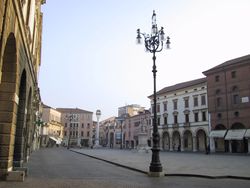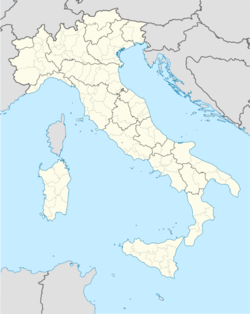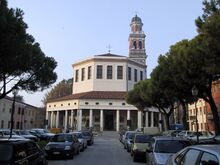روڤيگو
روڤيگو | |
|---|---|
| Città di Rovigo | |
 Piazza Vittorio Emanuele II. | |
| الإحداثيات: 45°4′13″N 11°47′26″E / 45.07028°N 11.79056°E | |
| البلد | إيطاليا |
| المنطقة | Veneto |
| المقاطعة | روڤيگو (RO) |
| Frazioni | القائمة |
| الحكومة | |
| • العمدة | Bruno Piva (شعب الحرية) |
| المساحة | |
| • الإجمالي | 108 كم² (42 ميل²) |
| المنسوب | 6 m (20 ft) |
| التعداد (30 نوفمبر 2011)[1] | |
| • الإجمالي | 49٬905 |
| • الكثافة | 460/km2 (1٬200/sq mi) |
| صفة المواطن | Rodigini |
| منطقة التوقيت | UTC+1 (CET) |
| • الصيف (التوقيت الصيفي) | UTC+2 (CEST) |
| الرمز البريدي | 45100 |
| مفتاح الهاتف | 0425 |
| Patron saint | St. Bellinus of Padua |
| يوم القديس | November 26 |
| الموقع الإلكتروني | Official website |
روڤيگو Rovigo مدينة في شمال إيطاليا وفي الجزء الجنوبي من إقليم ڤـِنـِتو، وعاصمة مقاطعة روڤيگو، تقع بين نهر أديجى شمالا وقناة بيانكو التي يوجد عليها ميناؤها. وتبعد عن ساحل البحر الأدرياتي 40 كم غرباً، جنوبا تعرف أيضا بCittà delle rose مدينة الأزهار، عدد سكانها 50.883 نسمة.[2]
. . . . . . . . . . . . . . . . . . . . . . . . . . . . . . . . . . . . . . . . . . . . . . . . . . . . . . . . . . . . . . . . . . . . . . . . . . . . . . . . . . . . . . . . . . . . . . . . . . . . . . . . . . . . . . . . . . . . . . . . . . . . . . . . . . . . . . . . . . . . . . . . . . . . . . . . . . . . . . . . . . . . . . . .
الجغرافيا
Rovigo stands on the low ground known as Polesine, 80 kilometres (50 mi) by rail southwest of Venice and 40 kilometres (25 mi) south-southwest of Padua, and on the Adigetto Canal. The comune of Rovigo extends between the rivers Adige and Canal Bianco, 40 kilometres (25 mi) west of the Adriatic Sea, except the frazione of Fenil del Turco that extends south of the Canal Bianco.
Polesine is the name of the low ground between the lower courses of the rivers Adige and Po and the sea; the derivation of the name is much discussed, generally applied only to the province of Rovigo, but is sometimes extended to the near towns of Adria and Ferrara.
التاريخ
Rovigo (both Rodigium and Rhodigium in Latin script) appears to be first mentioned in a document from Ravenna dating April 24, 838; the origin of the name is uncertain. In 920 it was selected as his temporary residence by the bishop of Adria, Paolo Cattaneo, after the destruction of his city by Hungarian marauders; the fortifications he ordered were already finished in 945. The viscounts of Rovigo built a line of brick walls in the 1130s in the name of the House of Este. The current Torre Donà is a remnant of the castle built some time in between; it is 66 m high and it may have been the highest brick tower at that time if the date of construction is correct.
In 1194 Rovigo became a formal possession of Azzo VI d'Este, duke of Ferrara, who took the title of conte (count) of Rovigo. The Este authority ended in 1482, when the Venetians took the place by siege and retained possession of it by the peace of 1484. Although the Este recovered the city during the War of the League of Cambrai, the Venetians, returning in 1514, retained possession until the French Revolution. In 1806 Napoleon I Bonaparte created it a duché grand-fief for general Anne Jean Marie René Savary. The Austrians in 1815 made it a royal city.
With the fall of the 1815–1866 Kingdom of Lombardy–Venetia, Rovigo was annexed to the Kingdom of Italy in 1866; in the same year it was connected by railway to Padua, Ferrara, Verona (through Legnago), and Chioggia (through Adria). In the 1900s the first modern industries were established, the most important of which was a sugar refinery. In 1927 the territory of the comune was extended including close municipalities. In 1937 the course of the Adigetto Canal was diverted to the west edge of the town and a large avenue called Corso del Popolo was built in place of the former course. In the years 1943–1945 Rovigo was part of the Italian Social Republic and it has been in Italy since 1946. In the 1950s and 1960s Rovigo had a dramatic development and it had the highest urbanization rate among the towns in the Veneto region after World War II.
الحكومة
المعالم الرئيسية
The architecture of the town bears the stamp both of Venetian and of Ferrarese influence. Main sights include :
- Rovigo Cathedral (Duomo, dedicated to Martyr Pope Steven I), the co-cathedral in the bishopric of Adria–Rovigo; it was originally built before the 11th century, but rebuilt in 1461 and again in 1696. The art works of the interior includes a Resurrection of Christ by Palma the Younger.
- Ruins of the Castle (10th century), of which two towers remain
- Madonna del Soccorso: church best known as La Rotonda. If was built between 1594 and 1606 by Francesco Zamberlan of Bassano, a pupil of Palladio, to house a miraculous image of a sitting Madonna with Child carrying a rose. The edifice has octagonal plan, surrounded by a portico, begun in 1594. The original construction had a cupola, which was later substituted by a simple ceiling for static reasons. The fine campanile, standing at 57 m, was built according to plans by Baldassarre Longhena (1655–1673). The walls of the interior of the church are wholly covered by 17th centuries paintings by prominent provincial and Venetian artists, including Francesco Maffei, Domenico Stella, Giovanni Abriani, Alessandro Varotari (il Padovanino), Pietro Vecchia, Pietro Liberi, Antonio Zanchi and Andrea Celesti.
- Immacolata Concezione : Church dating to 1213.
- San Francesco: church in Gothic-Romanesque style but with extensive intervention from the 19th century. The belfry is from 1520. In the interior are several Saints sculptures by Tullio Lombardo (1526).
- The Town hall, which contains a library including some rare early editions, belonging to the Accademia de Concordi, founded in 1580, and a fair picture gallery enriched with the spoils of the monasteries.
- Palazzo Roverella, largely restored but still example of Renaissance architecture, now serves as town art gallery.
- Palazzo Roncale: Renaissance palace (1555) by Michele Sanmicheli
- Palazzo Venezze (1715)
- Pinacoteca dei Concordi ("Concordi Gallery") houses important paintings, including a Madonna with Child and Christ with the Cross by Giovanni Bellini, a Flagellation of Christ by Palma the Elder, a Venus with the Mirror by Jan Gossaert, and portraits by Tiepolo and Alessandro Longhi.
القرى المجاورة
Barchessa Candiani, Basso Cavallo, Boara Polesine, Boaria San Marco, Borsea, Braga-Cantonazzo, Buso, Busovecchio, Ca'Bianca, Ca'Matte, Ca'Lunga, Campagna Terzi, Campagnazza, Cantonazzo, Capolavia, Ca'Rangon, Concadirame, Corte Lazzarini, Fenile Morosina, Fenil del Turco, Granzette, Grignano Polesine, Grompo, Grumolo, Le Cassette, Le Giarelle, Le Sorbolaro, L'Olmo, Lusia, Mardimago, Roverdicrè, San Sisto, Santa Libera, Santa Rita, Sant'Apollinare, Sarzano and Spianata.
المدن الشقيقة
 بدفورد، المملكة المتحدة
بدفورد، المملكة المتحدة تولسيا، رومانيا
تولسيا، رومانيا ساتونيڤري، بوركينا فاسو (تعاون دولي)
ساتونيڤري، بوركينا فاسو (تعاون دولي) Schlanders، إيطاليا (صداقة)
Schlanders، إيطاليا (صداقة) فيرنهايم، ألمانيا
فيرنهايم، ألمانيا
انظر أيضاً
الهامش
المصادر
- Various (1988). Rovigo. Ritratto di una Città. Rovigo: Minelliana.
. . . . . . . . . . . . . . . . . . . . . . . . . . . . . . . . . . . . . . . . . . . . . . . . . . . . . . . . . . . . . . . . . . . . . . . . . . . . . . . . . . . . . . . . . . . . . . . . . . . . . . . . . . . . . . . . . . . . . . . . . . . . . . . . . . . . . . . . . . . . . . . . . . . . . . . . . . . . . . . . . . . . . . . .
وصلات خارجية
- Short description is different from Wikidata
- Articles containing إيطالية-language text
- Pages using gadget WikiMiniAtlas
- Pages using infobox settlement with image map1 but not image map
- Italian commune articles with missing parameters
- Articles with hatnote templates targeting a nonexistent page
- مدن إيطاليا
- أماكن مأهولة في ڤـِنـِتو
- صفحات مع الخرائط






